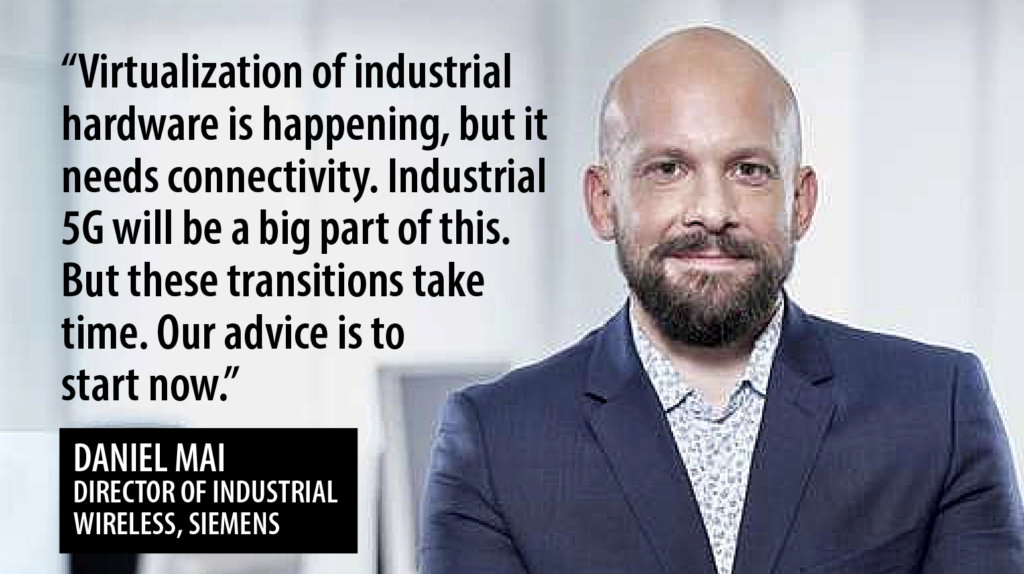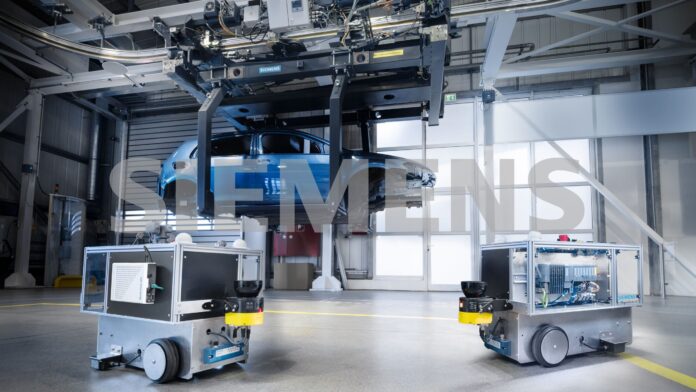“Demand [for private 5G] will rise… but it will take years,” comments Daniel Mai, director of industrial wireless at Siemens, in conversation last month at Hannover Messe – picking up from where we left off here (see previous post: Private 5G and generative AI – ‘where Industry 4.0 gets real’, says Siemens).
There’s that familiar reserve, again. What does Siemens make of all the hype in the 5G market? (The question should be whether the AI hype is any different; but it has already said on stage that it is different, and a bunch of other questions flow anyway.) How big does Siemens think the market actually is? Does it regard this seminal forecast from Nokia about 10 million factories as accurate, and useful; or is the firm most interested in Release 18-level URLLC and TSN for high-fidelity factory automation? And is that a niche market, actually?
“I can’t tell the future,” responds Mai. “But it’s an enabler; that’s how we implement it and that’s how we pitch it.” He references recent work with Volkswagen subsidiary Audi, taking the firm’s newly launched virtual PLC product to reduce shop-floor hardware and streamline production at a factory in Ingolstadt, in Germany; it has a similar project with Ford in the US. (He says something about parallel work with Deloitte, as well, which has emerged as a key integrator for its private 5G system.) The point is just that factories are being twinned and controlled in software, and better networks are needed for the task.
Mai explains: “Virtualization of industrial hardware is happening, but it needs connectivity. Industrial 5G, and probably 6G at some point, will be a big part of this. But these transitions take time. Our advice to customers is to start now, to be ready – because starting in five years might be too late.” His 2025/26 timeline (see previous post), for private 5G to properly pick-up in Industry 4.0, is consistent with what Siemens has always said, and makes the post-hype deflation in the telecoms market look silly. Certainly, 5G-ACIA sounded a little deflated on stage here, at Hannover Messe.

So what does Siemens, which paints itself as a realist in a gallery of fantasists, make of the mood in the rest of the market? Presumably, the hype is no-bother and the delay is no-sweat – because it shows its timing is right? “The deflation, compared to the hype, is correct. But if you see what generative AI can do, then you will see how it picks up,” says Mai, again referencing the looming AI cardio workout for industrial data systems. He is saving-up the examples, but Siemens has already talked-up its Teamcenter platform as the heart-pump in the new Industry 40 anatomy.
The arms and legs just need to be connected properly, the message goes. So, let’s stick with 5G for the moment: how many systems has Siemens sold? “It’s still early-days, and our customers now have official-product, and not just test hardware; and we have a pipeline of projects. But I don’t want to give numbers,” responds Mai. As an aside, on prompting, he suggests the official licence-count from regulator BNetzA in Germany (370 private 5G permits have been granted, said 5G-ACIA on stage in Hanover) is misleading on the grounds they cover enterprises, not networks.
“I doubt that number,” he says. “I mean, Siemens is counted as one, and I know very well that Siemens has deployed a lot of 5G networks.” It has deployed even more industrial wireless LAN (Wi-Fi) systems in factories around the world. Its view on how industrialised versions of these networking technologies converge is worth a punt – as the only OT vendor offering either (versus OT stalwarts like Rockwell and Schneider, with no skin in the game), and the only OT vendor offering both (versus IT outfits Cisco and HPE, at both tables, playing with different hands).
So how do 5G and Wi-Fi come together in Industry 4.0? “It depends who you talk to,” says Mai. “From my point of view, 5G is a customer driven business – because it’s infrastructure. Whereas Wi-Fi is more like an OEM technology – because it is available everywhere.” So Wi-Fi is a box-sale? “Exactly,” he responds, going on to explain that new factories are being constructed with both just because Wi-Fi is easily available but hardly reliable and 5G is easily reliable but hardly available. “There will be a coexistence, of course, and we will put in both,” he says.
He tells how “many times” a factory phones up because an AGV application, working for years, comes unstuck when new lights are mounted on the ceiling and then connected to the network. “All of a sudden there are issues with interference. Because Wi-Fi uses unlicensed spectrum. That kind of thing happens all the time. But we are also in a transition phase with 5G – because the ecosystem of machine suppliers is not supplying assets with 5G connectivity.” Right, so 5G and Wi-Fi are different in terms of their purchase and installation; but what about their management?
Because that’s what others say – that they will converge at the management-layer. That’s what the IT-5G vendors say. “Yes. Because they provide enterprise connectivity. Shop-floor connectivity is very different. In IT, you have this CIA [information security] model [prioritising confidentiality, integrity, and availability], say; whereas OT has an AIC model, which prioritises availability. Because the lifecycle is different. We are dealing with robots and trains, which do their jobs for 20 years; not smartphones and laptops, which are obsolete in three-to-five. There is no rip-and-replace.”
Mai goes on: “IT/OT convergence is clearly happening, but the OT part will be taken care of by the OT department. Because it is a car manufacturer making cars – and not an IT office with a factory in the basement. Yes, the shop floor needs to push the data somewhere; all of that is happening. But it will mostly go to the edge, and not to the cloud. And this idea of IT-driven enterprise-wide connectivity, I just don’t see it.” But last year, at this event, the head of Volkswagen’s IT department said 5G needs to work like Wi-Fi. Is that correct? “Yes,” says Mai.
But how does that chime with what you’re saying – that 5G should be different, so far as OT remains separate from OT. It is a little unfair, because the Volkswagen presentation is remembered from a year-ago; but Mai soldiers on: “It means that 5G needs to be as easy to deploy as Wi-Fi. Because 5G will be in every factory – Wi-Fi for generic connectivity and 5G for critical connectivity. But it needs to be maintained by OT staff. Because they are in charge of production. It’s not just a server that needs rebooting, but a whole production line – in a controlled manner.”
He goes on: “Which is something a standard IT department can’t do. IT and OT need to collaborate, but the requirements are different. IT is a cost centre, and OT is a profit centre, and costs are always streamlined. Harmony in OT comes with all-different vendors – because you can’t get everything from one. But there’s a reason why companies go with a specific brand of laptop or a specific service in their data centres – because it’s easier, and so they can swap between suppliers in the blink of an eye. Which is not how OT works.”
It is forceful and interesting, even if time is up and we haven’t got into the nuts-and-bolts of easy industrial-grade 5G management for OT (and how that tallies with a “customer-driven business”). But the message from Siemens is clear, going back to the start: that it is different to every other 5G vendor, hailing from the traditional ICT and IT fields, precisely because of its OT heritage and know-how. Responding again to the question about why Siemens is different in the private 5G space, Mai responds: “Because we build factories – end-to-end. Connectivity is just a small part, an enabler – everything else is what [all the other 5G vendors] are lacking. That makes us unique, and a trusted partner.”

